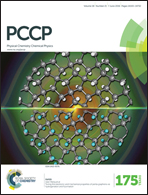Lithium storage on carbon nitride, graphenylene and inorganic graphenylene†
Abstract
We present results of density functional theory calculations on the lithium (Li) ion storage capacity of three different two dimensional porous graphene-like membranes. The graphitic carbon nitride membrane, g-CN, is found to have a large Li storage capacity of at least 813 mA h g−1 (LiCN). However, it is also found that the Li interacts very strongly with the membrane indicating that this is most likely irreversible. According to the calculations, graphenylene or biphenylene carbon (BPC) has a storage capacity of 487 mA h g−1 (Li1.5C6) which is higher than that for graphite. We also find that Li is very mobile on these materials and does not interact as strongly with the membrane making it a more suitable anode material. Inorganic graphenylene, which is a boron nitride analog of graphenylene, shows very low binding energies, much lower than the cohesive energy of lithium, and it appears to be unsuitable as an anode material for lithium ion batteries. We discuss how charge transfer leads to the very different behaviour observed in these three similar materials.


 Please wait while we load your content...
Please wait while we load your content...